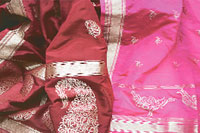Calligraphy Rescues the Dying Folk Art
 Kafeel’s Urdu calligraphy on wooden items; Maqbool’s calligraphy on silk saris
Kafeel’s Urdu calligraphy on wooden items; Maqbool’s calligraphy on silk saris
Bahadur Chitrakar has been painting all his life. Some might say it’s in his blood, considering his father, grandfather and all those before them were Kalighat painters. But to Chitrakar — a caste name derived from his profession — it’s a parampara (tradition) that must be carried on.
Until a year ago, the 38-year-old native of Naya, a village of chitrakars in West Midnapore district of West Bengal, wasn’t sure how long he would be able to sustain living on the art form. With no education and only his talent to keep him going, Chitrakar would travel across West Midnapore with his paintings — depicting folk tales and scenes from the Ramayana — and set up pop-up shops. He’d also sing the stories to regale his audience, who would enjoy his acts, but wouldn’t buy his paintings. “They would give us rice, grains and roti for our efforts. We would pack up and return home,” he says.
Just when Chitrakar was about to give up, he came in touch with Jaya Jaitley, political and social activist when she visited his village last year. Along with 58 other karigars — craftsmen, artisans and weavers — from 16 states and speaking 14 different languages, Chitrakar was brought under the fold of Akshara, Jaitley’s project that promotes indigenous arts and crafts by teaching regional languages at the workshops it holds in different cities. It introduces the artists to different calligraphic styles of writing, instilling “a level of pride” in their regional languages, and in the process, helps promote their crafts, says Jaitley. She launched Akshara in 2007; three years later, the first exhibition of the artisans' works was held in Chennai. Now they are gearing up for their second, but much larger, exhibition — over 100 works of the artisans, with 21 different techniques, will be displayed at the India Habitat Centre in Delhi between September 16 and 21.
Source:
Calligraphy is a remedy and mental gymnastics.



